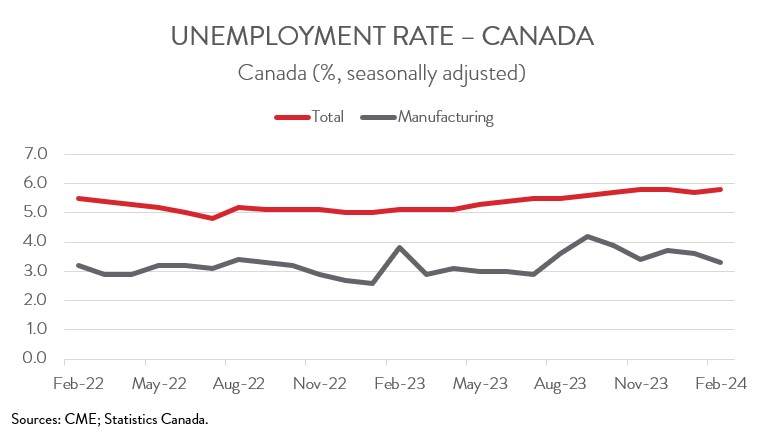Labour Market Trends
Labour Market Trends
February 2024
Canadian Economy Continues to Add Jobs in February, but Manufacturing Remains on Downward Trend
HIGHLIGHTS
- Employment rose 40,700 (+0.2%) in February, building on the 37,300 jobs added in January.
- Manufacturing employment fell 13,900 (-0.8%), the fourth decline in five months.
- Employment was up in 10 of the remaining 15 major industries, led by accommodation and food services and professional, scientific and technical services.
- The unemployment rate moved up a tick to 5.8%, while the jobless rate in manufacturing dropped 0.3 percentage points to 3.3%.
- Year-over-year wage growth in the manufacturing sector accelerated to 4.8% in February, up from 4.0% in January.
- Total employment was up in 7 of 10 provinces, with Alberta and Nova Scotia posting the most impressive gains. The decline in manufacturing employment was widespread and concentrated in Quebec and Manitoba.
- For the second consecutive month, the underlying details of today’s report were less impressive than the headline figure, indicating that the Canadian economy continues to limp along.
EMPLOYMENT CLIMBS, BUT UNDERLYING DETAILS MIXED
Employment rose 40,700 (+0.2%) in February, building on the 37,300 jobs added in January. That said, it bears repeating that the Canadian economy currently needs to generate about 45,000 new jobs each month to keep up with the country’s rapid population growth, a much higher threshold than in years past.

For the second consecutive month, the underlying details of today’s report were less impressive than the headline figure, indicating that the Canadian economy continues to limp along. While the increase in employment was driven by full-time work, the public sector and self-employment categories accounted for all of the growth.
MANUFACTURING EMPLOYMENT CONTINUES TO DECLINE
Manufacturing employment fell 13,900 (-0.8%) in February, the fourth decline in five months and indicative of the continuing loss of momentum and weakness in the sector. In fact, all of the job gains made in the first half of 2023 have been erased. Clearly, the last several months have been challenging for manufacturers as they face numerous headwinds, including persistent workforce challenges, high interest rates, and soft global demand.
Elsewhere, employment was up in 10 of the remaining 15 major industries, led by accommodation and food services (+26,200), professional, scientific and technical services (+17,900), and construction (+10,500). Along with manufacturing, these gains were partly offset by pullbacks in educational services (-17,000) and wholesale and retail trade (-16,800).
UNEMPLOYMENT RATE TICKS UP
The headline unemployment rate moved up a tick to 5.8% in February and has remained in a narrow range of 5.7% to 5.8% since October 2023. In contrast, the jobless rate in manufacturing fell 0.3 percentage points to 3.3%, the lowest level since July 2023.

WAGE GROWTH IN MANUFACTURING REACCELERATES
Average hourly wages eased to a 5.0% year-over-year pace in February from 5.3% in the previous month. Still, this is more than double the historical average and clearly higher than what the Bank of Canada would like to see.
On the other hand, wage growth in the manufacturing sector re-accelerated in February, coinciding with the drop in the unemployment rate and tighter labour market conditions. The average hourly wage rate in the sector increased by 4.8% year-over-year in February, up from 4.0% in January. The average factory worker earned $34.46 an hour in February 2024 compared to $32.87 an hour in the same month a year ago.

ALBERTA LEADS OVERALL EMPLOYMENT GAINS
Regionally, employment increased in 7 of 10 provinces in February. The biggest absolute gain was recorded in Alberta (+17,400), while the largest proportional increase was observed in Nova Scotia (+6,300). Alberta’s economy has created nearly 100,000 jobs over the last 12 months, the most among the provinces. On the negative side, employment in Manitoba and Newfoundland and Labrador declined by 5,300 and 1,800, respectively, last month.
In the manufacturing sector, employment was down in seven provinces in February, with job losses concentrated in Quebec (-9,700) and Manitoba (-3,200). The only notable increase (in proportional terms) was observed in Nova Scotia (+600). Taking a longer-term view, manufacturers in Ontario (+9,200) have created the most jobs over the past year, while manufacturers in Quebec (-10,300) have shed the most workers.
